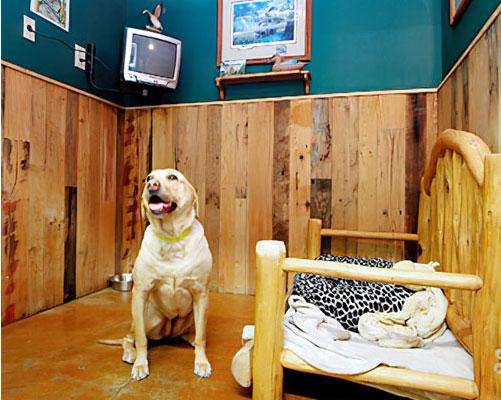Finding Peace of Mind: Dog Boarding for Reactive Dogs
When it comes to our canine companions, ensuring their comfort and happiness is a top priority for every pet owner. But for those with dogs that exhibit reactivity—their barking, lunging, or growling can stem from fear, anxiety, or territorial instincts—finding suitable accommodations can feel like a daunting task. Dog boarding facilities often cater to a wide range of temperaments, but a reactive dog requires a specialized understanding and approach to ensure their unique needs are met. In this article, we’ll explore the ins and outs of dog boarding for reactive dogs, offering insights and strategies for selecting the right environment that prioritizes both safety and well-being. Join us as we navigate the nuances of canine behavior, uncover tips for preparation, and highlight what to look for in a facility that can provide a nurturing experience for your sensitive pup.
Table of Contents
- Understanding Reactive Behavior in Dogs and Its Impact on Boarding Experiences
- Choosing the Right Boarding Facility for Reactive Dogs
- Effective Communication with Staff: Preparing for Your Dog’s Stay
- Strategies to Support Your Reactive Dog During Boarding Transitions
- Q&A
- Future Outlook
Understanding Reactive Behavior in Dogs and Its Impact on Boarding Experiences
Understanding a dog’s reactive behavior is essential for anyone considering boarding their furry friend. Reactivity in dogs often manifests as excessive barking, lunging, or growling when they feel threatened or overwhelmed by stimulus. These behaviors can stem from various factors, including fear, anxiety, or frustration. Recognizing the signs of reactivity is vital, as it allows caretakers to implement strategies that cater to the dog’s needs during their stay. Here are some common triggers for reactive behavior:
- Other dogs or animals
- Strange noises or environments
- New people or unfamiliar settings
When boarding reactive dogs, it is crucial to create a nurturing and safe environment tailored to their specific needs. A well-structured routine can significantly reduce anxiety and minimize potential triggers while ensuring your dog’s comfort. Additionally, boarding facilities equipped to handle reactive dogs should offer individualized care and training techniques, such as positive reinforcement. Consider the following aspects when choosing a boarding facility:
| Feature | Importance |
|---|---|
| Individualized Attention | Helps reduce stress and anxiety |
| Safe and Enclosed Spaces | Prevents exposure to triggers |
| Experienced Staff | Ensures proper handling and care |
| Structured Routines | Creates familiarity and comfort |
Choosing the Right Boarding Facility for Reactive Dogs
When selecting a boarding facility for your reactive dog, it is crucial to prioritize their unique needs and challenges. Look for facilities that specialize in handling dogs with reactive behaviors, ensuring that staff is well-trained in canine body language and behavior modification techniques. Consider the following aspects when evaluating options:
- Staff Experience: Ensure staff members are experienced with reactive dogs and understand their triggers.
- Environment: The facility should offer a safe, calm environment with limited exposure to stressful stimuli.
- Individualized Care: Seek out places that provide personalized attention and tailored exercise plans.
Observe how the facility manages interactions between dogs. Facilities that allow for controlled introductions and have separate spaces for different temperaments can greatly reduce stress for reactive dogs. Additionally, inquire about their protocol for emergencies, as understanding how they handle difficult situations can offer peace of mind. Here’s a quick reference table to assist with your evaluation:
| Criteria | Ideal Facility |
|---|---|
| Calm Environment | Noise control, limited foot traffic |
| Personalized Attention | Small group sizes, one-on-one interactions |
| Emergency Protocols | Clear plans, trained staff ready to act |
Effective Communication with Staff: Preparing for Your Dog’s Stay
Clear and concise communication with boarding staff is vital for ensuring your dog’s comfort and well-being during their stay, especially for reactive dogs. When preparing for your dog’s visit, consider providing detailed information to the staff about your dog’s specific behaviors and triggers. This can include:
- Triggers: Identify situations or stimuli (e.g., loud noises, unfamiliar dogs) that might provoke a reaction.
- Daily Routine: Share your dog’s regular schedule, including feeding times, walk routines, and play preferences.
- Behavioral History: Inform them about any past incidents that may help staff understand your dog’s behavior and anticipate their needs.
Additionally, a clear understanding of your dog’s comfort level with strangers, other animals, and new environments is crucial. Creating a personalized care plan can greatly enhance your dog’s boarding experience. Consider filling out an information table to summarize key points, such as:
| Details | Description |
|---|---|
| Favorite Activities | Playing fetch, tugging, or scent games |
| Feeding Schedule | Twice a day, morning and evening |
| Medication Needs | Requires daily medication at noon |
| Preferred Isolation Techniques | Quiet space away from noise |
Strategies to Support Your Reactive Dog During Boarding Transitions
Transitioning a reactive dog into a boarding environment can be challenging, yet with the right strategies, it can become a more manageable experience for both the dog and the caregivers. Start by familiarizing your dog with the boarding facility ahead of time. Arrange for a pre-boarding visit, allowing your dog to explore the environment, meet staff, and scent-mark the area. This exposure helps reduce anxiety by encouraging a sense of ownership and comfort within the new space. Additionally, providing a familiar item from home, such as a blanket or toy, can offer emotional support, creating a sense of security amidst the unfamiliarity.
Establishing a clear communication plan with the boarding staff is crucial. Prepare a detailed behavioral profile that highlights your dog’s triggers and calming techniques. An effective profile may include:
| Information | Details |
|---|---|
| Triggers | Other dogs, loud noises, unfamiliar spaces |
| Calming Techniques | Quiet room, individual walks, calming music |
| Favorite Activities | Fetching a ball, gentle play, puzzle toys |
By ensuring the staff understands your dog’s needs and preferences, you foster a smoother transition. Regular updates via text or video can also ease your mind, allowing you to feel connected and informed while your dog adjusts to its temporary new home.
Q&A
Q&A: Dog Boarding for Reactive Dogs
Q1: What does it mean for a dog to be reactive?
A1: A reactive dog typically exhibits strong, often defensive, responses to certain triggers in their environment, whether it’s other dogs, people, or specific noises. This behavior can stem from various factors, including fear, anxiety, or a lack of socialization. It’s crucial to understand their triggers to ensure a safe and calm environment for them.
Q2: Is it safe to board a reactive dog?
A2: It can be safe to board a reactive dog, but it requires careful planning and consideration. Finding a boarding facility experienced in handling reactive dogs is essential. Look for places that offer a calm environment, personalized care, and staff trained in canine behavior to help keep your dog comfortable and secure during their stay.
Q3: How can I determine if a boarding facility is suitable for my reactive dog?
A3: Start by asking specific questions about their experience with reactive dogs. Inquire about their training protocols, the number of dogs they accommodate at once, and their ability to create a structured environment. A reputable facility will be open to discussing these concerns and may even invite you for a visit to observe their practices firsthand.
Q4: What should I prepare my dog for before boarding?
A4: Preparing your reactive dog for boarding starts at home. Introduce them to the idea of being away from you gradually. Practice short separations and consider crate training, if applicable. Providing the boarding staff with detailed information about your dog’s triggers, routines, and calming techniques can also help ensure a smoother transition.
Q5: What can I do if my dog becomes stressed during their boarding stay?
A5: If you’re concerned about your dog’s stress levels while boarding, discuss potential coping strategies with the facility beforehand. Many places use calming techniques, such as quiet spaces, individualized attention, or interactive toys. You might also consider sending familiar items, like a favorite blanket or toy, to provide comfort.
Q6: Are there any alternatives to traditional dog boarding for reactive dogs?
A6: Yes, there are various alternatives to traditional boarding for reactive dogs. These include in-home pet sitters who can provide one-on-one attention, doggy daycare facilities specifically designed for reactive dogs with low-traffic environments, or even arranging for a trusted friend or family member to look after your pet.
Q7: Can training improve my dog’s boarding experience?
A7: Absolutely! Training can make a significant difference in your dog’s behavior and their overall boarding experience. Working on basic obedience commands, socialization skills, and desensitization to their specific triggers will help your dog feel more confident and less reactive, making them better equipped to handle new environments.
Q8: What can I do if my dog isn’t adapting well to boarding?
A8: If your dog struggles to adapt, it’s essential to communicate with the boarding staff. They may have insights or suggestions based on their observations. If challenges persist, consider re-evaluating your choices or options, including shorter stays or further training before attempting boarding again.
Q9: How do I know if my reactive dog had a good boarding experience?
A9: After picking up your dog, watch for signs of happiness and relief, like wagging tails, relaxed body language, and eagerness to be with you. It’s also helpful to ask the boarding staff for feedback on your dog’s behavior and any specific incidents during their stay. A good facility will provide you with detailed information about your dog’s experience.
Q10: Is there any long-term impact on my reactive dog from boarding?
A10: While the experience can vary depending on the dog and the boarding situation, most dogs will adjust over time. A positive boarding experience can help build your dog’s confidence in new environments as they become familiar with being away from home. However, a stressful stay might necessitate extra socialization or training afterward to help your dog regain their comfort level.
Conclusion: Boarding a reactive dog certainly presents unique challenges, but with thoughtful preparation and careful selection of the right facility, both you and your furry companion can navigate this experience positively. Remember, knowledge is power—equipping yourself with the right information will lead to a smoother journey for your beloved pet.
Future Outlook
As we wrap up our exploration of dog boarding options tailored for reactive dogs, it becomes clear that selecting the right environment is crucial not only for your pet’s comfort but also for their well-being. Each dog is unique, and understanding their specific triggers and needs allows you to make informed decisions that foster a peaceful and nurturing boarding experience. Whether you choose a specialized facility, a pet-loving friend, or seek out an experienced caretaker, prioritizing your dog’s individual temperament is essential.
In a world where our furry companions thrive on routine, patience, and understanding, a thoughtful approach to dog boarding can transform a potentially stressful separation into a positive adventure. Remember, the journey of finding the perfect boarding solution may take time, but the peace of mind that comes from knowing your reactive dog is in safe, skilled hands is well worth the effort. As you embark on this journey, may you find joy in discovering the ideal haven for your beloved canine—a place that embraces their quirks and celebrates their spirit. Happy boarding!



